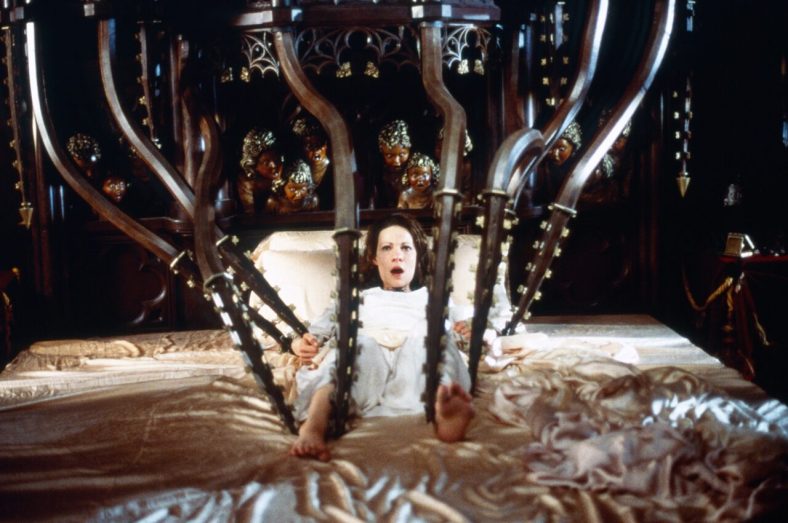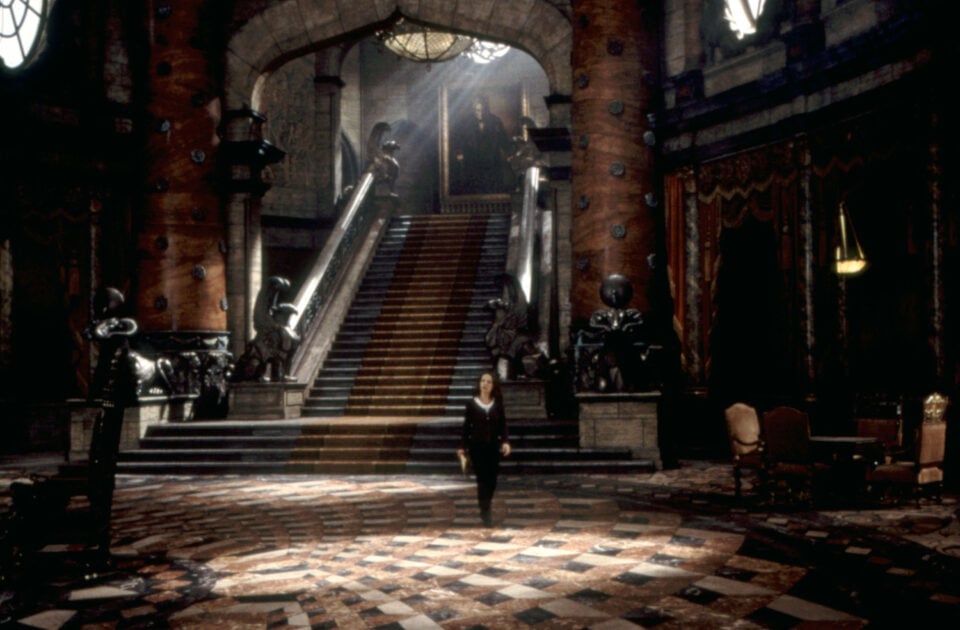Digital Ghosts and Stunning Architecture in ‘The Haunting’

Jan de Bont’s The Haunting might have dropped the “Hill House” from Shirley Jackson’s original title, though the house is unequivocally the star. With exteriors filmed in England at Harlaxton Manor and Belvoir Castle alongside phenomenal interior sets designed by Argentinian production designer Eugenio Zanetti, The Haunting’s identity is its architecture. Some houses might be born bad, but they look great while misbehaving.
Widely believed to be a remake of Robert Wise’s seminal, queer-coded masterpiece The Haunting, also adapted from Jackson’s original text, de Bont’s The Haunting is instead another adaptation, with the filmmakers’ failure to secure the remake rights no doubt accounting for the brazen indifference toward 1960s Gothic fidelity. Titled as such to avoid confusion with another house and another hill– William Malone’s House on Haunted Hill— The Haunting is Jackson’s story in name only. Even Mike Flanagan’s miniseries adaptation is arguably more faithful to the original template than what de Bont accomplishes here.
First conceived by Steven Spielberg and Stephen King, King would later leave the project on account of creative differences, reworking his original script into Rose Red, the source of universal nightmares in the early aughts. King reportedly hates The Haunting, and he’s not the only one. Critical reception was grim, with The Haunting having quite the showing at both The Golden Raspberry Awards and Stinkers Bad Movie Awards. However, $180 million at the box office tells a different story.
Produced with an estimated $80 million budget, every cent was on display. In an era of expensive movies that look like piles of dirt, it’s analeptic to go back and watch a movie preeminently interested in how it looks. The visual effects might look dated now, though, at the time, they were groundbreaking. The Haunting put every dollar on the screen, and not once does it look anything less than marvelous.

There are beats where Lili Taylor’s Eleanor Vance is lit only by a swinging pendulum light. Grappling with a supposed ghost in her room, Eleanor is lit, cast into darkness, and lit again. The grounds outside Hill House are verdant in a way most contemporary cinema despises, and cinematographer Karl Walter Lindenlaub (a regular Roland Emmerich collaborator) knows how to make an image look expensive. Natural light melds with artifice, and still, frames are dripping with texture. Light and shadow organically populate the hidden corners and sprawling halls of Hill House, never once drawing the audience’s attention to the source of light unnaturally.
Which, of course, is to say nothing of the house. Much like Poltergeist, Spielberg’s original conception no doubt endeavored to rework antiquated haunted house tropes. Akin to the recently released Man, F*** This House (Brian Asman), Hill House is the antagonist here, a literal representation of proprietor Hugh Crain’s innate wickedness.
Eleanor’s supposed psychic predilections are muted here, leaving space for the architecture to manifest the sundry digital haunts on display. While da Bont doesn’t resist suggestion entirely, the circumspect scares are often the weakest. Like Hill House, the best moments are horror behemoths.
As Hugh Crain, textile tycoon and child murderer, develops his grip over both the home and the pseudo-insomniacs staying there, he and the house become one in the same. This Hill House has mirrored carousels, doors replete with biblical imagery, and a hallway passage books as stepping stones over streams, with Catherine Zeta-Jones’ Theo offhandedly referring to the manor as “Charles Foster Kane meets The Munsters.”Suitably gothic and brazenly baroque, the set design is nothing less than gorgeous, never more so than when Crain’s evil is perceptible.
In a climactic scene, Hugh Crain possesses Eleanor’s bedroom. His eyes become part of the archivolt and his spirit manifests in the windowpane. Bed posts become appendages and the house expands and retracts as Crain inhales and exhales, both with and as the house. Owen Wilson meets his graphic end via a beastly chimney flue, and the ever-moving camera tracks Crain’s ongoing possession of portraits, gargoyles, and magic carpets.
The Haunting is never still. Jan de Bont’s camera resists staying in one place for very long—after all, he has an entire house to show us. There are seamless transitions from back windshield to massive estate, split diopter lenses, and an eye for uncanny angles that disorient and frighten. The nightmarish atmosphere merges with a $10 million set ($20 million adjusted for inflation). Everything from the oil portraits to the cherub sculptures is rendered marvels.
There has never been a haunted house like The Haunting. Earnest to a fault, the slim narrative might regularly falter under the massive weight of Hill House’s legacy, though with this much eye candy, it’s easy to forgive. The committed cast gives it their all, but they’re merely window-dressing. This haunting belongs to Hill House. Here, Hill House is a star.
Categorized:Editorials News

